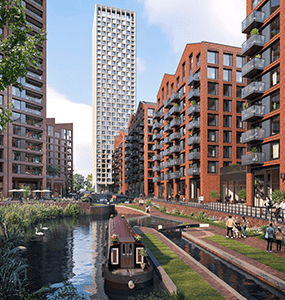Glasswater Locks, Birmingham
Regeneration Case Study
- 3.1-acre brownfield site in the heart of Birmingham’s Learning Quarter
- 762 mixed-tenure homes
- Circa 13,000 sq ft of commercial space
- Distinctive canalside setting
- Forecast to deliver a 23% biodiversity net gain
At Glasswater Locks, St Joseph is transforming a derelict industrial site on the Digbeth Branch Canal into a distinctive waterside neighbourhood, offering a mix of homes, amenities, shops and high-quality public space.
Opening up a new gateway between Birmingham's Eastside and the city's vibrant Learning Quarter, Glasswater Locks is in walking distance of Aston University, Birmingham City University and the forthcoming Curzon Street Station. The site will be reconnected to the surrounding community through a network of new pedestrian and cycle routes.
Long Term Brownfield Regeneration
Key Challenges:
- Complex site involving close working with multiple partners, including Birmingham City Council, Homes England, Canal & River Trust and Birmingham City University
- Complex construction logistics to manage the interface with the public and Canal & River Trust-owned towpath and tunnel
- Relocation of crane bases as part of enabling works
- Delivering a biodiversity net gain on site

Inspired By The Former Belmont Glassworks
Glasswater Locks sits alongside the Digbeth Branch Canal, with archaeological excavations revealing the base of a Boulton & Watt steam engine, which was part of a pumping station needed to raise water levels along the canal. Excavations also revealed boundary walls and kilns that once belonged to Belmont Glassworks, a company active on site from 1803.
Glassmaking was one of the city’s major manufacturing industries in the 1800s, with glassworks being established along waterways to provide transportation.

Opening Up the Site
With new pathways and sustainable transport infrastructure, the community will be able to access this part of the canal for the first time in generations.
- New gateway connection between Lawley Middleway and the Digbeth Branch Canal
- Improved access points onto the canal
- Walking and cycling routes throughout the development
- A canalside public square

Sustainable Design
Glasswater Locks will include a mix of amenities and infrastructure that will encourage active, sustainable lifestyles.
- Target 23% biodiversity net gain
- Bird and bat boxes and green and bio-solar roofs will be incorporated throughout the development to further enhance and support existing wildlife
- Energy efficient building fabric
- Walking and cycling routes throughout the development
- Electric car charging infrastructure and 762 secure cycle spaces
- Sustainable urban location close to existing transport and social infrastructure

Local Jobs and Skills Development
The Glasswater Locks Employment and Skills Plan provides a mix of skills training, apprenticeships and job opportunities for local people.
- 20.7% of directly employed staff are apprentices, graduates or in training
- Supporting local Berkeley Foundation charity partners, including MyBnK, Crisis and St Basils
- Partnership with The Change Foundation to deliver the Street Elite programme
- Working with The Skills Centre to offer structured pre-employment training to support Birmingham residents into construction careers
- Partnership with the Passion Project to offer construction training to ex-offenders in construction
- Collaboration with Ladder for Birmingham to support residents into employment and training
Our Partners
Planning Authority: Birmingham City Council
Architect: Howells Architects
Landscape and Ecology: Murdoch Wickham | Ecology by Design
Local Partners: Canals & Rivers Trust | Birmingham City University | Birmingham City Council



